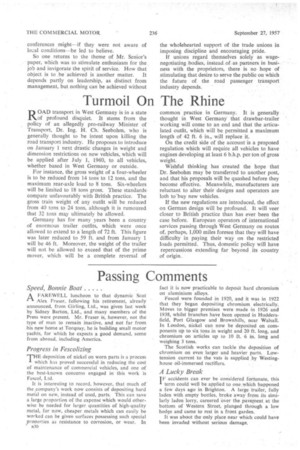Passing Comments
Page 36

Page 37

If you've noticed an error in this article please click here to report it so we can fix it.
Speed, Bonnie Boat
AFAREWELL luncheon to that dynamic Scot
Alex Fraser, following his retirement, already announced, from Girling, Ltd., was given last week by Sidney Barton, Ltd., and many members of the Press were present. Mr. Fraser is, however, not the type of man to remain inactive, and not far from his new home at Torquay, he is building small motor yachts, for which he expects a good demand, some from abroad, including America.
Progress in Fescolizing
THE deposition of nickel on worn parts is a process which has proved successful in reducing the cost of maintenance of commercial vehicles, and one of the best-known concerns engaged in this work is Fescol, Ltd.
It is interesting to record, however, that much of the company's work now consists of depositing hard metal on new, instead of used, parts. This can save a large proportion of the expense which would otherwise be needed for larger quantities of high-quality metal, for now, cheaper metals which can easily be worked can be given surfaces possessing such special properties as resistance to corrosion, or wear. In B30 fact it is now practicable to deposit hard chromium on aluminium alloys.
Fescol were founded in 1920, and it was in 1922 that they began depositing chromium electrically. Moves to bigger premises were made in 1926 and 1938, whilst branches have been opened in Huddersfield, Port Glasgow and Brownhills, near Walsall. In London, nickel can now be deposited on components up to six tons in weight and 20 ft. long, and chromium on articles up to 10 ft. 6 in. long and weighing 3 tons.
The Scottish works can tackle the deposition of chromium on even larger and heavier parts. Lowtension current to the vats is supplied by Westinghouse oil-immersed rectifiers.
A Lucky Break
IF accidents can ever be considered fortunate, this I term could well be applied to one which happened a few days ago in Brighton. A large trailer, fully laden with empty bottles, broke away from its similarly laden lorry, careered over the pavement at the bottom of Western Street, plunged through a low hedge and came to rest in a front garden.
It was about the only place near which could have been invaded without serious damage.
Useful Gadgets at Repair Depot
A PARTY of members of the institute of Road
Transport Engineers, who last week visited the motor repair centre of Shell Mex and B.P., Ltd., at F,ulham, were much impressed by the many interesting and novel devices which had been put into use to expedite the maintenance work.
It is well known that the upper face of cylinder blocks frequently warps. Normally, to correct this requires a complete strip down, but at this works it can be carried out in two hours, including lifting the head and plugging the bores and other holes to prevent entry of the carborundum paste that is employed. The "tool" used is a heavy iron casting with criss-cross cutsand a hinged handle, it resembles a reversed face plate and is passed to and fro across the top of the cylinders.
The smooth, or nearly smooth, treads of large tyres are rapidly and cheaply re-cut to the usual or a new non-skid pattern by means of a simple electric tool made by Karl Zangl, of Munich, which costs about £13. In its head this carries a wire loop, which can 'be changed to suit the cut required. Immediately the loop is pressed on to the tyre, the head carrying it is pushed back and makes contact. The loop then becomes bright red and the cutting is rapid.
This tool was mentioned and illustrated on page 730 of The Commercial Mator dated June 28, in connection with an article on the food-distribution fleet of Marsh and Baxter, Ltd.
The injection-pump shop is well equipped with Hartridge and other testers, including a simple plunger-leak tester with a weighted arm which drops when the movement is completed. This and other devices ensure 300,000 miles effective use of pump barrels and plungers.
It is believed that the lift of injectors is most important and a dial gauge ensures uniformity of this particular equipment.
To obtain clean cutting of tank-door ,flanges and other parts, propane instead of acetylene is used for the torches.
Useful axle stands are made from three old Scammell brake drums, filled with concrete and with L brackets mounted on the top drum.












































































































